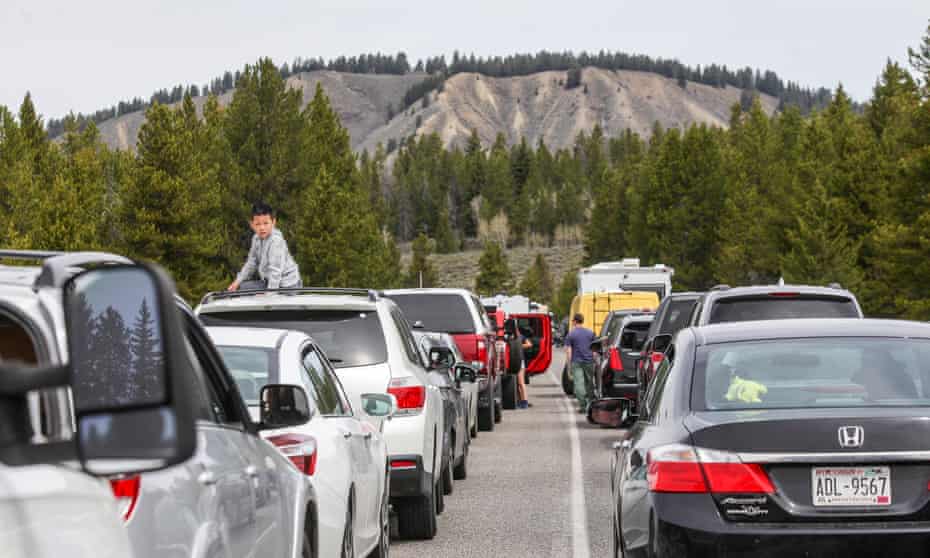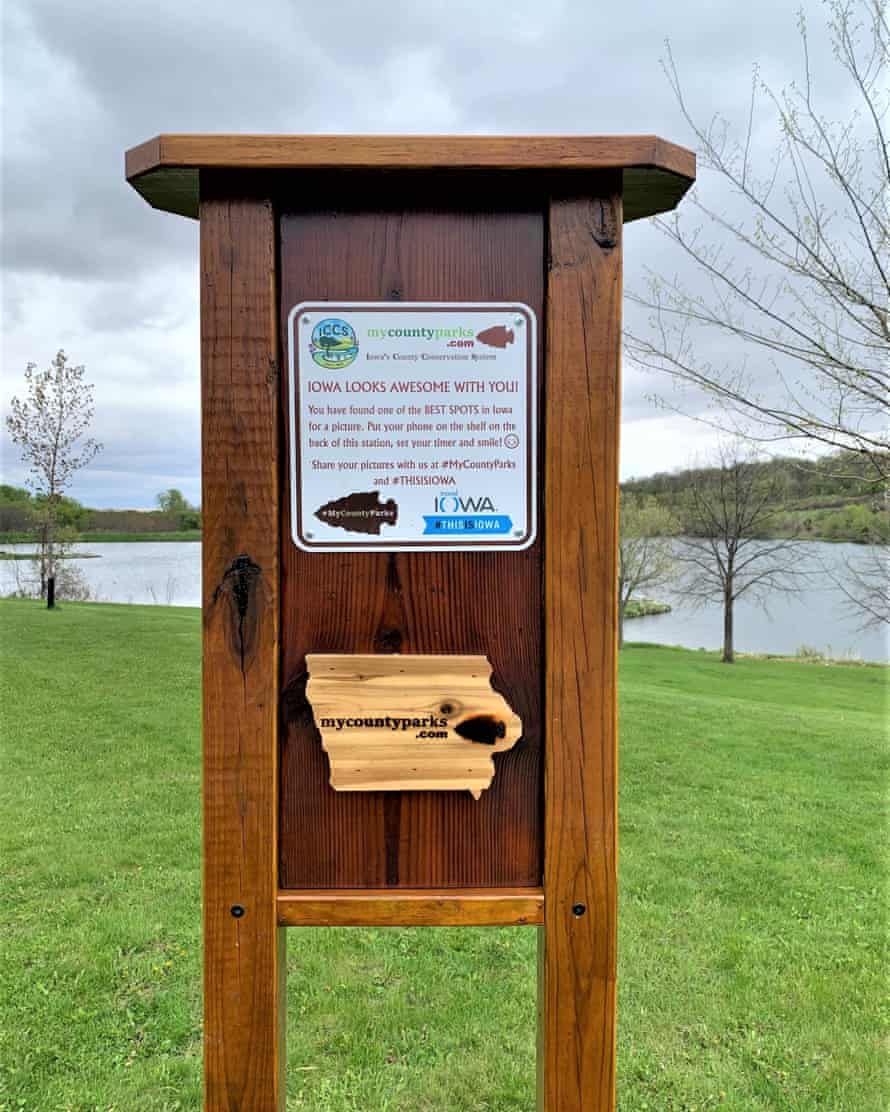US national parks are overcrowded. Some think ‘selfie stations’ will help

The park service is turning to selfie stations, timed tickets and crowd-monitoring apps to preserve public lands
Arches national park had to close its gate more than 120 times this summer alone when parking lots filled up, creating a safety hazard for emergency vehicles. Yellowstone national park reached 1 million visitors in July for the first time in its history. At Zion national park, the wait for a hike was a Disneyland-long four hours. And with the visitors came graffiti, trash and reckless behavior.
“It’s no secret that this summer has been one of our busiest summers ever,” says Jenny Anzelmo-Sarles, the chief spokesperson for the National Park Service. “We don’t have official numbers, but preliminary visitation statistics show that the most popular 12 to 15 national parks are seeing record numbers.”
The record-setting crowds of people surging into public lands this summer has set off new challenges for park managers. They are using counterintuitive tricks like encouraging selfies in one place to prevent them in another, and they are rolling out algorithms and autonomous vehicles to manage the throngs of recreation-seekers.
They are also acknowledging a hard truth: perhaps there simply isn’t enough space at America’s most iconic attractions for everyone who wants to visit them.
One of the biggest issues facing parks is the many visitors all aiming to get the perfect photograph. At popular spots in Yosemite and near the Grand Canyon, some have even fallen to their deaths in the process, prompting the National Park Service to create a guide for safe selfie-taking. And in 2018, the tourism board in Jackson Hole, Wyoming, made an unusual request to visitors heading toward Grand Teton national park after local trails were overrun with photo-tourists: stop geotagging photographs.
Enter the selfie station: a humble wooden stand in front of a stunning vista, ready to hold a camera for a safe and easy photo experience. They are part of an effort to corral people’s natural desire to take photos and to promote less-well-known areas.
Tom Hazelton, who leads Iowa’s County Conservation System, has overseen the installation of more than a hundred selfie stations in his state. Hazelton says some of the stations celebrate quirky parts of history, like the first train robbery west of the Mississippi, while others point people to a lake, vista or nature center they might not otherwise come across. Similar efforts exist in Wisconsin and Minnesota.
“They’re nice, sturdy, cedar stations,” says Hazelton, who says it’s the state’s third season using the stations, and they just installed another 15 here in the past few months. “They are getting used and they are low maintenance and easy to build: the signs are $30 and the wood is another $60 and there you go.”

Another tactic to reduce the strain on parks is to cut the number of visitors permitted to enter them in the first place. The National Park Service oversees a total of 423 protected places that include national seashores, national lakeshores and national monuments, among others. Popular places like the summit of Haleakala on Maui or Muir Woods in California require timed entry slots, available on Recreation.gov. More public lands are turning to such systems to reduce the number of visitors in any one part of a park, especially as the pandemic trimmed staffing numbers.
The Recreation.gov program uses algorithms to show where there might be less-trafficked attractions in the vicinity that you’re searching in real time, says Will Healy, part of the team at Booz Allen Hamilton who built the site. The National Park Service also launched an app this year that points people to other potential public lands outside the parks. “If you’re going to Glacier, what are some of those other opportunities in the area if you couldn’t get that reservation in Glacier national park?” says Anzelmo-Sarles, such as Grant-Kohrs Ranch national historic site, where visitors can learn about the history of ranching. .
Even so, not everyone likes timed entry reservations. Critics opposing timed entry at Rocky Mountain national park created a petition to fight the system, calling it unfair, unnecessary and undemocratic.
In the future, the Park Service is focusing on rolling out predictive technologies that will allow people to anticipate crowds and plan accordingly. Anzelmo-Sarles says they are taking tools used in urban planning and congestion planning and repurposing them for recreation and parks.
That could mean a future where a hiker scans a QR code to check in at a trailhead, sending information back to when the trails are most clogged with people. That way, the next group could be advised to wait an hour or come another time to take the same adventure. It also could mean that traffic is routed to less popular areas of the parks.
To cut down on traffic, some parks are experimenting with autonomous cars. The Wright Brothers national memorial in North Carolina tested out a driverless shuttle this summer, and Yellowstone is also trying a shuttle. That park is expected to run out of space for additional cars by 2023. The idea, says Anzelmo-Sarles, is to stop people driving between the sights in the Canyon Village area – the area around the famous Yellowstone river and Tower Waterfall – and get them in the driverless shuttle instead.
Another way to maintain a sense of peace on public lands is simply by reminding visitors that it’s what they came for. At Muir Woods national monument, where 500-year old trees tower above a mossy forest in northern California, a number of signs ask visitors to “maintain natural quiet” by speaking softly, muting electronic devices and being aware of their noise levels.
A study in 2011 showed that signs declaring such quiet zones or quiet days actually worked: surveys showed visitors were supportive of the practice, and sound level measurements showed substantial decreases on days and places the signs were posted.
The quiet zones drive home the importance of the acoustic environment as a way to experience natural places, says Rachel Buxton, a conservation biologist who used to work at the Park Service’s natural sounds and night skies division. “It’s a resource that’s under threat and might be disappearing. And maybe if we can appreciate it more, we might be more motivated to protect it.”
She adds that it’s one thing to see Yellowstone’s famed geysers – but alongside that experience is hearing them. “It’s all part of that experience and it’s all part of the treasure of these landscapes. So just really encouraging people to open their ears up and appreciate it as a really incredible resource.”
Despite the crowds and the traffic and noise, the park service says it’s a good thing that more people are getting out to experience parks and public lands. “We want people to have exceptional experiences and we’re looking at ways to enhance opportunities for people to plan to have the best experience and stay safe,” says Anzelmo-Sarles.
This report was made possible in part by the Fund for Environmental Journalism and the Society of Environmental Journalists.
.png)